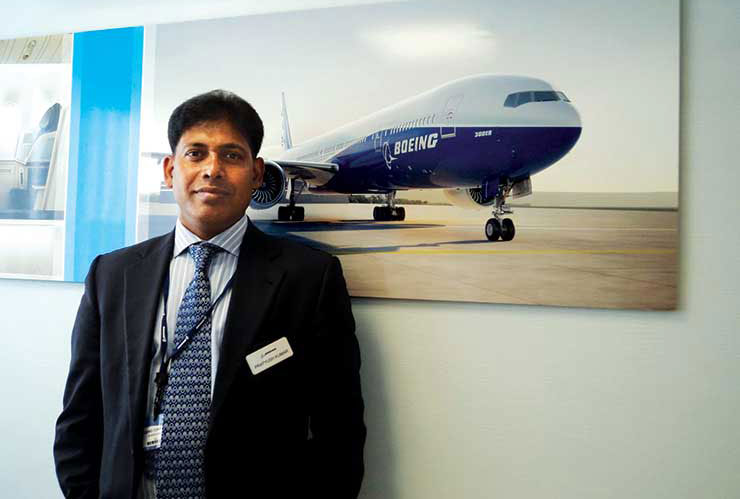
PRATYUSH KUMAR is President of Boeing India and Vice President of Boeing International, and he also serves as Managing Director of Boeing Defence India. Based in New Delhi, Kumar is Boeing’s most senior in-country executive who integrates and advances Boeing’s activities in India across its three business units: Boeing Commercial Airplanes (BCA), Boeing Global Services (BGS), and Boeing Defense, Space & Security (BDS).
Prat is Chairman of the American Chamber of Commerce, India (AmCham), Chairman of the FICCI Aviation Committee, and a member of the executive council of the Aviation Cooperation Program (ACP) between India and the United States. He also serves on the board of Aerospace and Aviation Sector Skills Council and CII Defense Committee.
An alumni of Indian Institute of Technology Delhi, he is a doctorate in materials engineering from the Massachusetts Institute of Technology (MIT), US where he was also an Industry Collegium fellow supported by the Leaders for Manufacturing program.
In a very recent development, Kumar has been assigned to lead Boeing Defense Program in the United States.
In an exclusive interview to PK Ghosh of Raksha Anirveda, Prat spoke at length on company’s various plans and initiatives in India. Excerpts of the interview:
Recently Boeing Apache and Chinook helicopters for India completed their inaugural flights. What’s your take on that?
Pratyush Kumar. The first flight of the AH-64 Apache and CH-47 Chinook for the Indian Air Force (IAF) represents a significant milestone in our partnership with India, which aims to support the modernization vision of the Indian armed forces. We are on a journey of continued commitment to strengthen the capabilities of the Indian armed forces and both the AH-64 Apaches and CH-47 Chinooks will be a landmark step in that direction.
Deliveries of 22 AH-64E Apache and 15 CH-47F (I) Chinook helicopters to India begins in 2019, can you elaborate how this will help modernising Indian Air Force’s copter fleet?
Pratyush Kumar. The AH-64 Apache attack helicopter has continuously evolved through the years to meet the requirements of the armed forces that operate this capable platform. The AH-64 Apache is the only combat helicopter with a spectrum of capabilities for virtually any mission requirement. It is uniquely suited to meet the commander’s needs, including reconnaissance, security, peacekeeping operations, and lethal attack—in both land and littoral environments—all without reconfiguration.
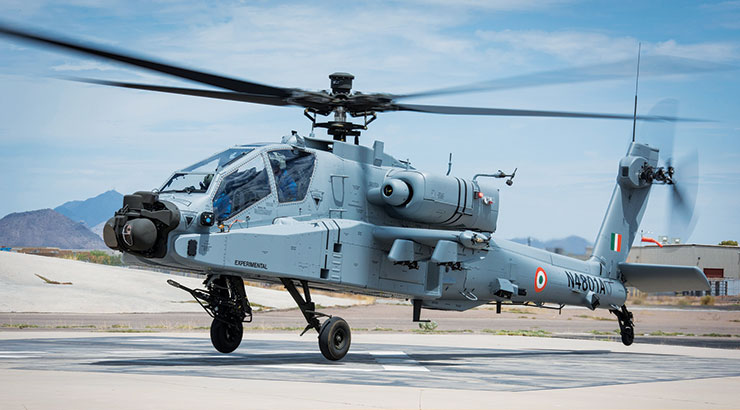
The CH-47 Chinook is a multi-mission helicopter that offers India heavy-lift and high-altitude transportation for a multitude of military, humanitarian, rescue, disaster relief, fire-fighting and nation-building missions in all climates, conditions and altitudes. The aircraft is ideally suited for India’s vast distances, austere environments and high altitudes.
Two (2) dedicated defense corridors, as announced in the budget, are coming up in Tamil Nadu and Uttar Pradesh. How do you visualise this development?
Pratyush Kumar. The development of these two defense corridors has the potential to further increase the momentum that the defense manufacturing ecosystem has gained under the ‘Make in India’ initiative. These two corridors will not only operationally streamline defense manufacturing in India, but will also open up a plethora of opportunities for small and medium enterprises (SMEs) situated along the corridor.
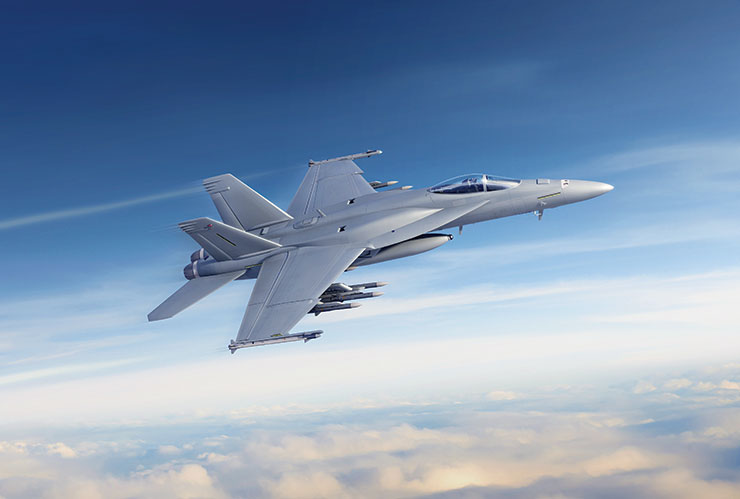
Please elaborate on your plans and strategies for the two defense corridors. Do you have any specific plan for UP Defense corridor besides a skill development centre in collaboration with HAL?
Pratyush Kumar. The creation of these defense corridors and the subsequent increase in industries is going to result in an increased number of job opportunities in the states. We will select young trainees for a world class curriculum from our facilities across the world. We will ensure that UP is catapulted to the highest levels and trainees generate world class equipment. We continue to assess opportunities to partner with like-minded Indian partners to support the ‘Make in India’ initiative, the ‘Skill India’ initiative and armed forces modernisation.
What’s your take on the governments (Central as well as the States) role as facilitators for the development of these defense corridors?
Pratyush Kumar.The Central and State Governments have shown commendable foresight and a progressive approach when it comes to promoting the growth of the Indian defense manufacturing ecosystem. The defense corridors in Uttar Pradesh and Tamil Nadu have the potential to benefit the states and the country as a whole in multiple ways that fulfill not only the goals of ‘Make in India’, but also the ‘Skill India’ and ‘Startup India’ initiatives.
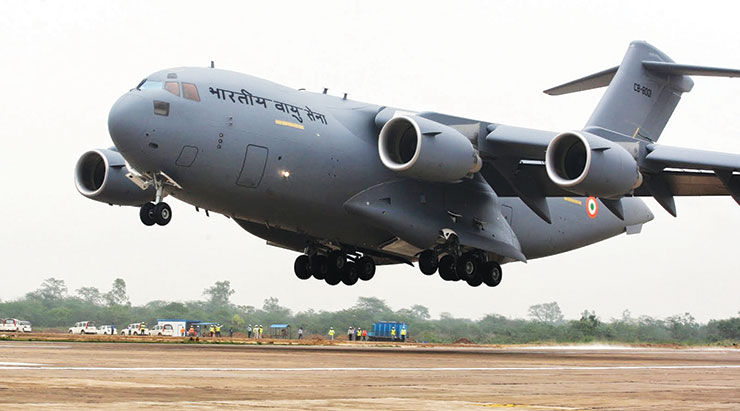
You have a significant footprint in India for years even much before the Prime Minister Modi’s announcement of Make in India. What do you think of your contribution to Make in India in terms of defense, space and security?
Pratyush Kumar.When Boeing looks at advantages across the world in quality, capability and talent, India is an obvious partner. “Make in India” is a core element of Boeing’s business strategy. As such, we are focused on our Indian partnerships to fully harness the productivity opportunity in India.
We have taken a dual approach of making equity and non-equity investments in support of Make in India. We partnered with Tata Advanced Systems to establish a joint venture that is now producing aerospace aerostructures in India, for the world. But it’s important to note that non-equity partnerships also can help grow the defense industrial base. Boeing has invested millions of dollars in supplier development, training, tooling and quality systems at Indian suppliers without taking an equity stake, and we continue to increase our partnerships with public and private companies. Boeing is working with over 160 Indian suppliers to provide advanced, complex components and subassemblies for our commercial and defense aircraft.
Apart from defense and aerospace, you have tied-up with some educational institute and DPSU like IITs and HAL respectively. Please explain what are the areas in which your company is active?
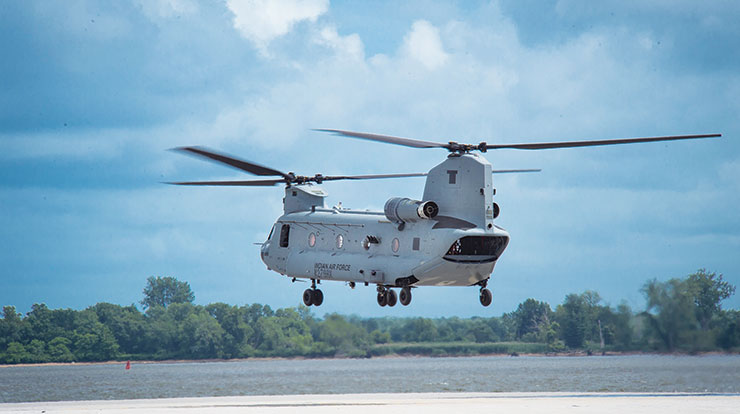
Pratyush Kumar.We have been making calibrated investment to accelerate Boeing’s manufacturing, skill development and engineering involvement in India, forging the way toward building a strong indigenous ecosystem in support of the ‘Make in India’ initiative while also supporting the ‘Skill India’ and ‘Startup India’ initiatives.
From P-8I to C-17 Globemaster to Apache and Chinook to Harpoon missiles, these are the products on offer for India. What next?
Pratyush Kumar. In the future, Boeing will continue to strengthen its relationships and continue building trust with our customers and industry partners to ensure that they get the right capabilities at the right time and the right cost, to deliver value.
We will continue to support the Indian Air Force and the Indian Navy to ensure that the mission-readiness of the C-17 Globemaster III and the P-8I continues to deliver increased operational capability. The same training and services support will also extend to the AH-64 Apache and CH-47 Chinook fleet, as they are inducted in the Indian Air Force.
We have responded to the Indian Navy and Indian Air Force fighter RFIs with the F/A-18 Super Hornet. We believe that the Super Hornet is the best fit for the Indian Navy and Indian Air Force’s fighter requirements and will fulfill the mission requirements of the Indian armed forces for decades to come.
Kindly elaborate on F/A-18 Super Hornet. How is it different from Lockheed Martin’s F-16 Block 70 and General Dynamics’ F-16 fighter variant in terms of capabilities and technologies?
Pratyush Kumar. The F/A-18 is the most modern and capable aircraft on the US Navy’s carrier decks today. In fact, the Block II Super Hornet reached initial operating capability in 2007. The F/A-18 Super Hornet was designed from day one for carrier operations and is the world’s preeminent carrier capable aircraft. It is a combat proven, supersonic, all weather multirole fighter jet with designed-in stealth with a defined US Navy flight plan to outpace threats,well into the 2040s.
The US Navy’s continued investment is an important proof point to the fact that this aircraft will continue to have the technologies needed to outpace threats for decades to come. Boeing and the Navy have laid out and maintained a robust spiral development approach to the Super Hornet that provides updates to the aircraft’s subsystems and software every two years.
Along with our industry partners, we have built more than Boeing 700 Super Hornets and Growlers, all on cost and on schedule. Boeing is confident that we will see F/A-18 production into the mid 2020’s based on the US Navy’s need for more aircraft and near-term international opportunities.
The Super Hornet not only has a low acquisition cost, but it costs less per flight hour to operate than any other tactical aircraft in US forces inventory. Part of its affordability is because the Super Hornet is designed to need far less maintenance, which translates into the high mission availability it is known for.
How F/A-18 is going to bolster Indian Navy and Indian Air Force’s defense and threat outpacing capabilities?
Pratyush Kumar. One look at the decks of our Navy’s aircraft carriers and the Royal Australian Air Force’s fleet and you’ll see advanced, combat-proven strike capability.
The Super Hornet brings the latest generation of technologies to the warfighter. The AESA radar in particular is an expediential leap in technology needed for current and future missions. The Advanced Targeting Forward Looking Infrared system, Joint Helmet Mounted Cueing System, Multifunctional Information Distribution System, advanced high capacity computer system, and state-of-the-art cockpit provides the warfighter with intuitive situational awareness and capability now and far into the future.
It is highly capable across the full mission spectrum and is a true multi-role aircraft, able to perform virtually every mission in the tactical spectrum, including air superiority, day/night strike with precision guided weapons, fighter escort, close air support, suppression of enemy air defenses, maritime strike, reconnaissance, forward air control and tanker missions. It has the right level of stealth, sensors and missiles for the Indian Navy’s and IAF’s mission requirements.
The Super Hornet Make in India proposal is to build an entirely new and state-of-the-art production facility that can be utilized for Advanced Medium Combat Aircraft (AMCA) program. Have you identified a place for the facility, please elaborate?
Pratyush Kumar. The Super Hornet brings the latest generation of technologies to the warfighter. With designed-in stealth and robust capability growth plan, the Super Hornet is the best aircraft to get to India’s Advanced Medium Combat Aircraft (AMCA) program. The Super Hornet Make in India proposal is to build an entirely new and state-of-the-art production facility that can be utilized for other programs like AMCA.
Boeing is prepared to bring its global scale and supply chain, its best-in-industry precision manufacturing processes as well as the company’s unrivaled experience designing and optimisng aerospace production facilities to both expand India’s aerospace ecosystem and help realize the Make in India vision. The approach addresses the infrastructure, personnel training, and operational tools and techniques required to produce a next gen fighter aircraft right here in India. We are in continual talks with our Indian industry partners on this and we will announce a suitable location when ready.
You have been in talks with around 400 Indian companies for producing Super Hornet in India. Your plans for producing fighter planes right here in India?
Pratyush Kumar. During DefExpo 2018, we announced a partnership with Hindustan Aeronautics Limited (HAL) and Mahindra Defence Systems (MDS) for manufacturing the F/A-18 Super Hornet in India for its armed forces and pursuing the joint development of future technologies. The partnership will transform India’s aerospace and defense ecosystem further building on its ‘Make in India’ success.
Boeing is excited to team up with India’s only company that manufactures combat fighters, HAL, and the Indian company that manufactures small commercial airplanes, Mahindra. This partnership brings the best of Indian public and private enterprises together in partnership with the world’s largest aerospace company, Boeing, to accelerate a contemporary, 21st century ecosystem for aerospace & defense manufacturing in India. Our partnership with HAL and Mahindra will enable us to optimise the full potential of India’s public and private sector to deliver next-generation F/A-18 fighter capabilities. Together we can deliver an affordable, combat-proven fighter platform for India, while adding growth momentum to the Indian aerospace ecosystem with manufacturing, skill development, innovation and engineering and job creation.
What are the areas your subsidiaries CDG and Jeppesen India work. Explain?
Pratyush Kumar. Jeppesen and CDG are Boeing’s global business units, which operate in India under Boeing India entity. Our 500 member team based in Chennai provides technical content development, software delivery and engineering design services for the aerospace and defense sector. Globally, Jeppesen has a broad portfolio of products and services that use leading-edge technologies to help customers optimise their operations. Some examples include sophisticated flight operations management and crew planning solutions, electronic flight bag applications and data, navigation and voyage optimization solutions for marine operators.
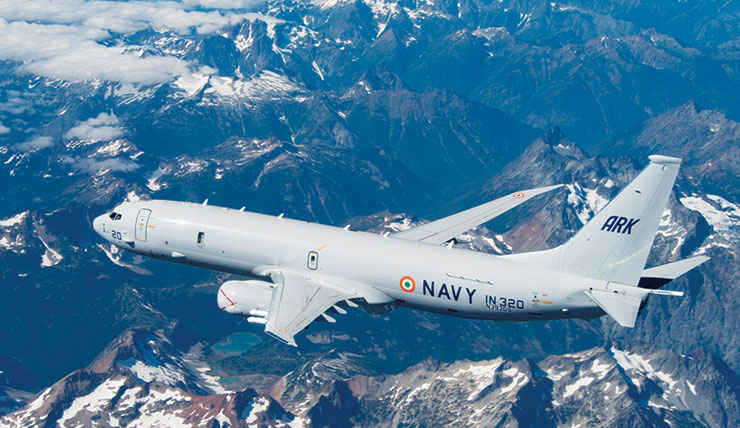
What are your future plans in the area of UAS/ UCAV apart from ScanEagle in collaboration with Insitu as UAVs are becoming necessity for modern day defense forces?
Pratyush Kumar. Having worked in the market segment for some time, we typically have customers with similar user requirements. Usually customers seek:
The ability to launch and recover a UAS by day and night, without having any impact on the platform operations. This means that there’s no shut down of the ship’s operations for the launch or recovery of the UAS and no need to launch another vessel to recover a UAS which has landed in the ocean.
Range and endurance. Customers are looking to acquire advanced warning and over the horizon capabilities as well as constant ISR over their direct area. The ability to alternate between the two from one platform is becoming key.
A payload which can automatically identify targets for users when scanning vast amounts of ocean is also important as it greatly improves the effectiveness of the UAS and the operator.
Globally we are seeing an increase in the UAS experimentation and queries as it is often seen as the cheaper and more effective mechanism to monitor large areas of strategic or tactical importance without compromising the mission objectives or the humans involved. As technology continues to evolve and improves we could start to see more unmanned or autonomous system operating with a ‘human in or on the loop’ philosophy.
We do see growth in the UAV sector as it reduces cost and increases effectiveness and more importantly removes a human from being put in harm’s way.
What is Boeing HorizonX India Innovation Challenge 1.0? How is it helpful in developing innovation in India?
Pratyush Kumar. Launched in November 2017, the Boeing HorizonX India Innovation Challenge 1.0 will energize aerospace innovation in India. It is our attempt to channelize India’s incredible talent and entrepreneurial energy for the future of innovation in aerospace and related areas. The challenge, in collaboration with India’s fastest growing startup T-Hub, invited the best Indian startups to propose solutions for complex challenges in the areas of autonomous & unmanned systems, advanced manufacturing, industrial IoT, analytics and artificial intelligence & machine learning. Boeing is currently in discussions with the winning startups and evaluating possible investments in their ideas. Boeing will also continue to mentor the startups and provide them opportunities to connect to other potential investors and expand their business with customers. Beyond the HorizonX challenge, Boeing is continually evaluating disruptive startups in India, for potential investments in the future.
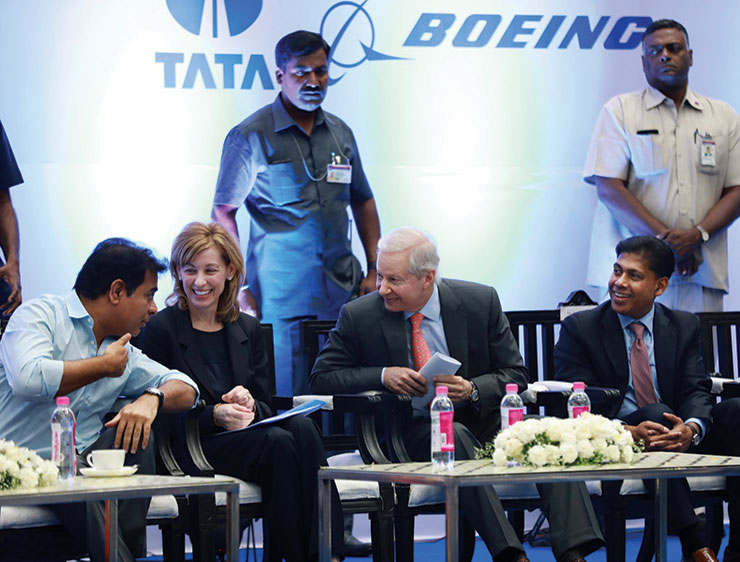
Tata-Boeing JV for aerospace in India? Any such plan for future defense and aerospace tie-ups in India?
Pratyush Kumar. The Tata Boeing Aerospace Limited (TBAL) facility was operational before schedule in July 2017. Three months after Defence Minister Nirmala Sitharaman inaugurated the facility, we delivered the first Apache combat helicopter fuselage from the facility. This is a major step towards future opportunities to pursue the co-development of integrated systems in aerospace and defense.
Boeing continues to work with suppliers in India in commercial and defense manufacturing. We have invested significantly in equipment, training, tooling and quality systems with partner companies that are now integrated into Boeing’s global supply chain. Partnerships of all types will be important going forward.
Final comment, if any?
Pratyush Kumar. We value India as a key aerospace market and a partner in progress. We are committed to enhancing our footprint and long-standing relationship with the Indian government and industry. The pace and depth of our engagement through products, services and partnerships has increased in recent years. We will remain committed to continuing our strong partnerships and continue to support the success of ‘Make in India’, ‘Skill India’ and ‘Startup India’.








